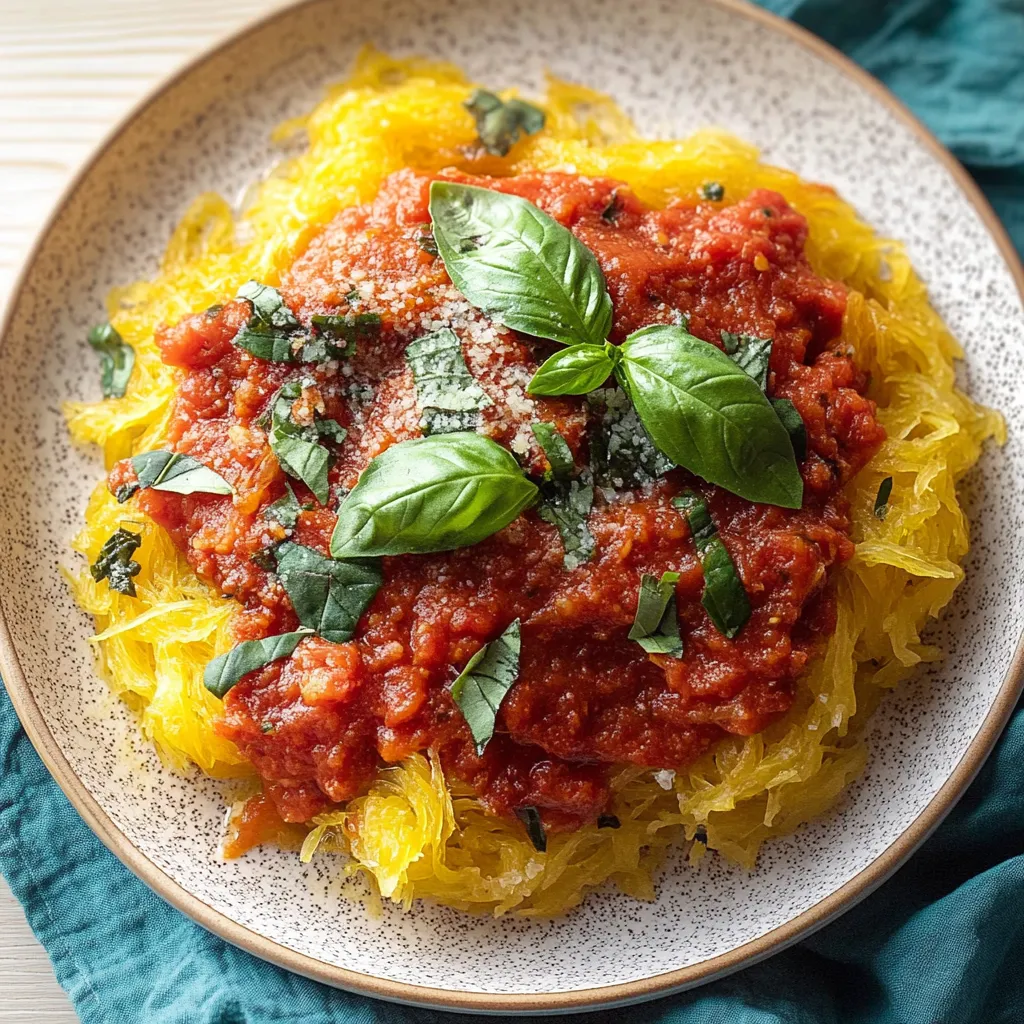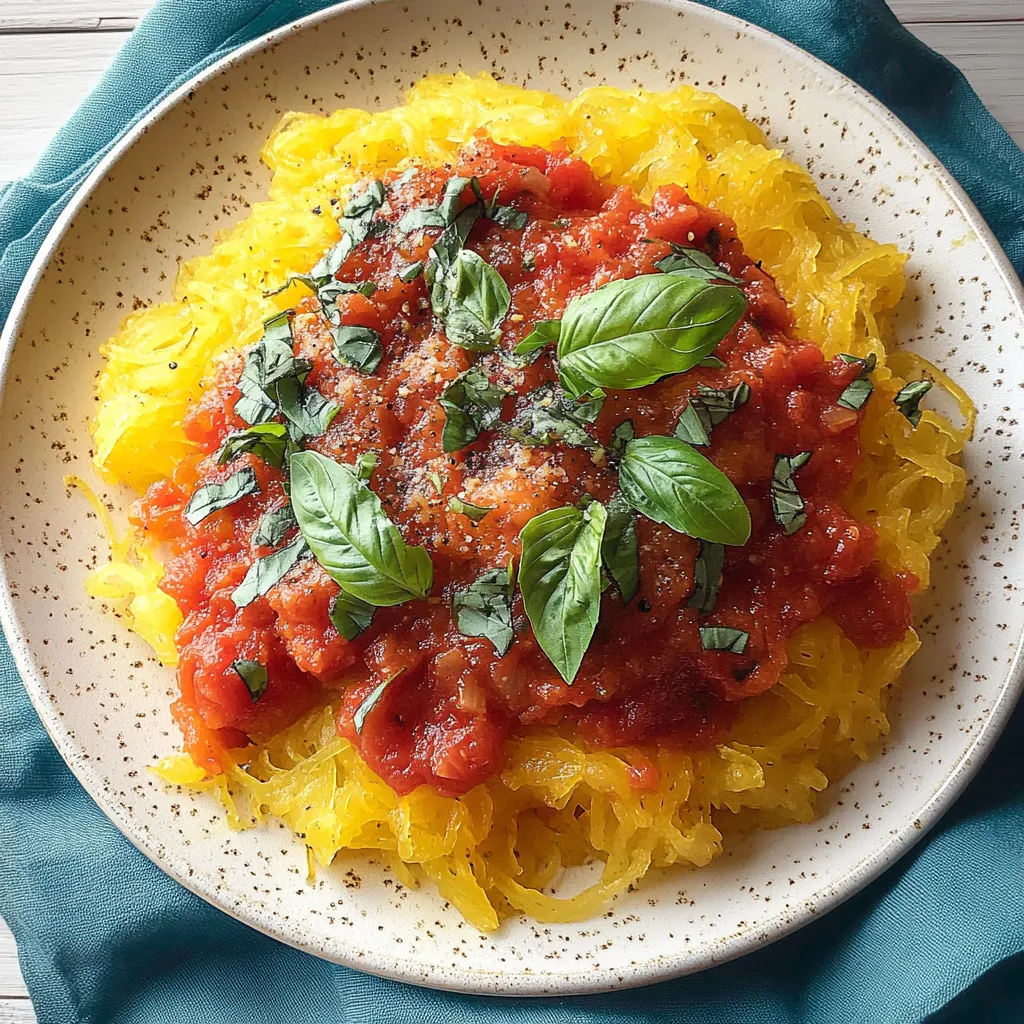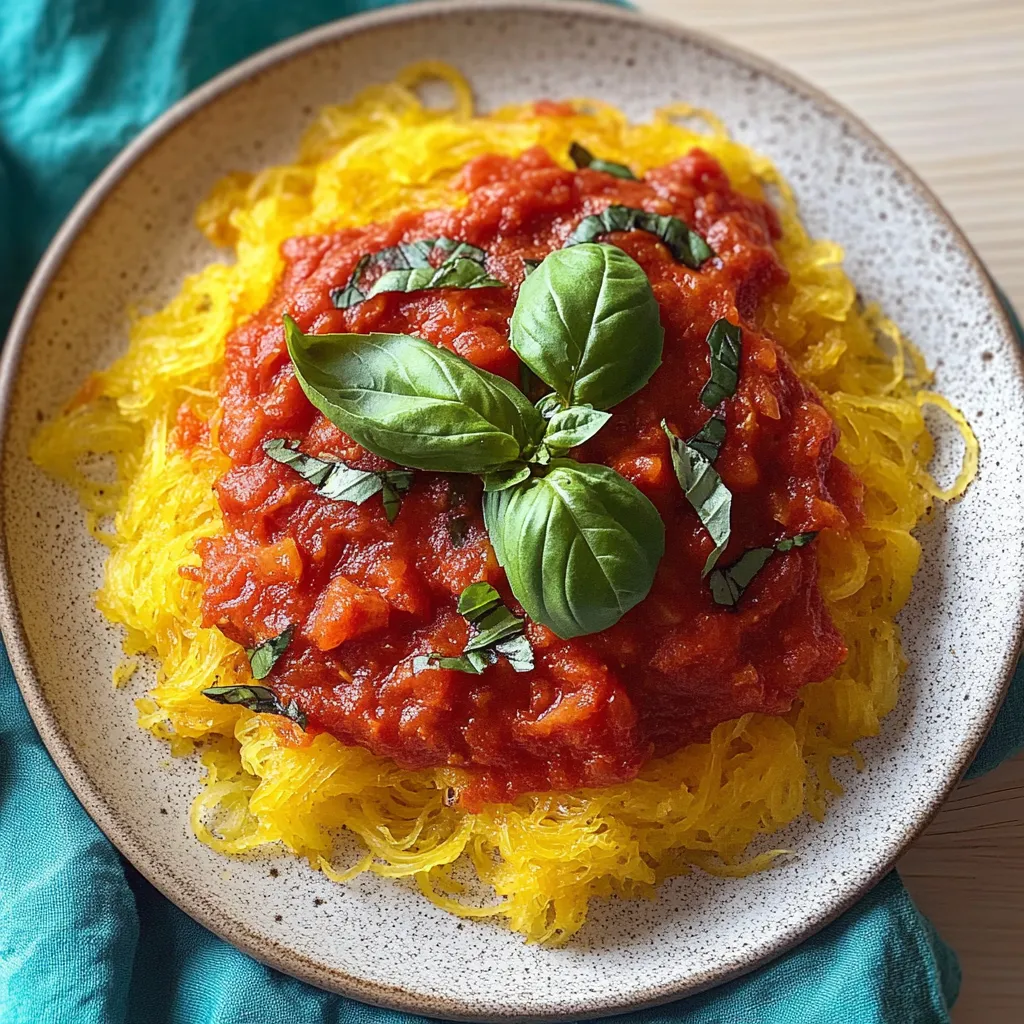 Save
Save
Spaghetti squash with marinara is a cozy comfort food that tricks you into thinking you’re eating the real deal—just without the extra carbs. You get soft, delicious squash strands roasted perfectly, all hugged with a bold, garlicky tomato sauce that seeps into every bite. The sweetness from the squash balances with the savory sauce, so you end up fuller than you’d expect but without feeling heavy. I first tried this out when I needed a lighter dinner, and I was honestly shocked at how filling and tasty a veggie “pasta” could be.
I whipped this up for my family on a random Sunday night, bracing myself for complaints about missing "real" noodles. Instead, everyone grabbed seconds—nobody could believe squash could be this good. My teenager even asked for it again for her birthday dinner, so you know it’s got kid approval! Those squash strands soak up the sauce in a way that’s just super satisfying.
Luscious Ingredients
- Fresh Basil: Tosses in a punch of aromatic freshness and bright flavor. Grab bright green leaves with no black marks for best taste.
- Spaghetti Squash: This veggie works wonders—it turns into spaghetti-like ribbons after roasting and has a soft, slightly sweet taste that’s perfect for strong sauces. Pick one that feels hefty and is blemish-free.
- Italian Seasoning: Usually a mix of thyme, oregano, basil, and rosemary, this makes the sauce herbal and complex—with no need to grab a bunch of jars.
- Extra Virgin Olive Oil: Brings out flavors and lets the squash brown up nicely in the oven. Use the best olive oil you can swing for bigger taste.
- Parmesan Cheese: Delivers savory, creamy goodness. Hunt for the stuff marked Parmigiano Reggiano that’s aged at least two years if you can, for depth.
- Crushed Tomatoes: These are the base for the sauce—thick enough to really stick to the strands. If you spot San Marzano, grab those for awesome flavor.
- Fresh Garlic: Lays down a perfect garlicky base for your sauce. Choose cloves that are firm and white, no sprouts if you want that clean taste.
Simple Steps
- Turn Into Strands:
- As soon as the squash is cool enough for you to hold (but still warm!), grab a fork and scrape the flesh—watch it fall apart into spaghetti-style pieces. Stop when all that’s left is the peel. Fluff the “noodles” up with your fork, so they don’t stick together and extra steam escapes.
- Make The Sauce:
- While that squash is roasting, get your sauce going: warm some olive oil in a deep skillet on medium. Toss in chopped garlic (and onion if you’d like) and cook it until it smells amazing but before it browns. Add in crushed tomatoes, Italian seasoning, salt, and pepper. Let it all bubble gently for about 15 to 20 minutes, stirring here and there so it doesn’t catch on the pan. That’s how you get the flavors to blend really well.
- Roast The Squash:
- Set your squash halves, cut side down, right on a baking tray lined with parchment. This way, steam gets trapped and helps the squash cook through while the outside gets lovely color where it touches the pan. After 35-40 minutes—might be more or less depending on squash size—check if it’s ready by poking with a fork; it should give way and the skin will look a bit saggy. The sweetness will really come out!
- Prep Squash:
- Start by getting your oven nice and hot at 400°F. You’ll need a sharp knife to slice the squash lengthwise. Apply pressure—these things are tough, so take it slow and steady. Scoop out all the pulp and seeds inside, just like a pumpkin. Douse the inside with olive oil and sprinkle with salt and pepper—make sure every bit gets some love.
 Save
Save
I learned the score-the-skin method after nearly cutting myself wrestling with a stubborn squash. My grandma later showed me how she’s been scoring squash and pumpkins forever—long before it was trendy. My folks now ask for this dish from the start of fall until winter’s end. Even my husband, who’s all about real pasta, prefers this lighter version now because of how great he feels afterward.
Top Partners
This dish teams up well with lots of things. Try it with a tossed green salad drizzled in vinaigrette that won’t overpower the bright tomato. Whole grain garlic bread is perfect for scraping up leftovers. If you want extra protein, go with grilled chicken breast or turkey meatballs—they pair right up with the lightness of the squash.
Want to get fancy? Scatter toasted pine nuts on top for extra crunch, or throw on some arugula that’ll wilt from the hot sauce, bringing a peppery kick. If you’re serving a crowd, let everyone pick toppings—like cheeses, chopped fresh herbs, or roasted veggies—to create their own bowl.
Tasty Swaps
Go Mediterranean: Change it up with olives, capers, and crumble feta cheese instead of Parmesan. The salty extras keep the sweetness of the squash in check. Want a flavor boost? Sprinkle fresh oregano on top.
Autumn Special: Add roasted butternut squash chunks and crunchy sage leaves into your sauce for a tasty seasonal twist. A small shake of cinnamon and nutmeg warms things up, and toasted walnuts add an earthy, toasty bite.
Try Asian Flavors: Ditch the tomato sauce. Mix the squash with ginger, garlic, soy, and a hint of honey. Top with scallions, sesame, and crispy tofu if you like for a whole new take that puts the squash front and center.
Chilled & Ready
How To Store: Let any leftovers cool down all the way before popping them in the fridge. Keep the sauce and squash in different containers, so the squash doesn’t soak up too much liquid and turn mushy. This also makes reheating and serving much easier.
How To Refresh: When reheating, add a splash of water to the squash in a covered pan and warm it gently. Heat up the sauce separately. When it’s all hot, mix them together and throw on some fresh Parmesan and herbs—it’ll taste almost new again.
Freezer Facts: The sauce keeps great in the freezer for up to three months, but the squash stays best when fresh. If you do need to freeze it, undercook it a little, freeze it in a single layer on a tray, then pack it up—this keeps the strands from clumping and lets you grab just what you need.
I actually jumped into using spaghetti squash as a healthy experiment, but now I choose it by default. It’s oddly satisfying turning a simple vegetable into something that feels both hearty and luxurious. First-timers are always amazed at how good veggie “pasta” can be. When you properly roast spaghetti squash, its sweetness sets the stage for big-flavored sauces—and the health perks are just icing. Want fewer carbs, more veggies, or just something new? This one’s a winner every time.
 Save
Save
Recipe FAQs
- → How can I tell when spaghetti squash is cooked through?
- You’ll know it’s done when the strands pull away easily with a fork. The texture should be soft but not falling apart—this takes about 35 to 40 minutes in a 400°F oven.
- → Is it possible to prep this dish ahead of time?
- Totally! Roast the squash and make the sauce up to three days in advance. Keep them in the fridge separately, and just warm them up when you're ready to serve.
- → Does this dish work for a vegan diet?
- The dish itself is vegetarian, but it’s easy to make it vegan. Just skip the Parmesan or swap it out for a vegan-friendly version.
- → Any ideas to make this meal more filling?
- You can add some protein like chickpeas, ground turkey, or sausage. For more veggies, sauté some spinach, peppers, or mushrooms and mix them in!
- → What’s a safe way to cut spaghetti squash?
- Slice it lengthwise with a sharp knife. If it feels tough, poke it with a fork a few times and pop it in the microwave for about 3-5 minutes to soften it first.
